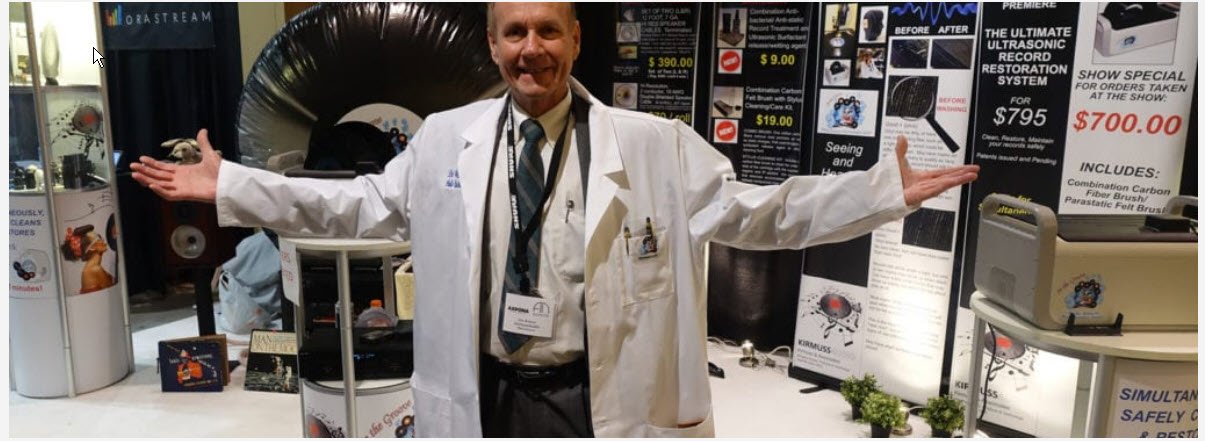Tima, I respect your opinion very much, as you are obviously one of the top experts on ultrasonic cleaning. But I seem to get very good results after using Kirmuss. Is your opinion based on personal experience or some faults in Kirmuss design that you know of?
Thanks in advance
This is all my opinion ...
I will not dispute that you are getting very good results after using Kirmuss' product and I will not try to persuade you to change. I support all people cleaning their records to enjoy them, preserving them for the future use and possible future owners, and for perpetuating the viability of the vinyl medium.
However ... after seeing videos of Kirmuss at shows, reading his various posts on his Web site, along with other's comments on other forums and doing some of my own research, I had no inclination to use what he offers. He changes his views, products and techniques over time.
I am put off by Kirmuss calling himself a Doctor and wearing a white lab coat as part of his sales pitch-- what I would call his 'act'. it strikes me as disengenuous, unserious and the exact opposite of what is needed for the advocacy of cleaning records.

His writing is unorganized, over-wrought and fancified to sound authoritative. For example he says his cleaning fluid is "diol-1-2-178 propanediol bipolar agent". What he doesn't tell us is this is simply propylene glycol, a common chemical that absorbs water to prevent it from beading up.
It seems half his pitch is devoted to saying what others do wrong without any real proof.
Kirmuss used to openly reject Tergitol 15-S-9 as the base of a cleaning solution. He seems now to have backed off of this, vaguely hinting that it is not safe to use. "A bath with distilled water alone or with a cleaning agent in an ultrasonic’ s tank added will not do anything to clean the grooves, it just lightly cleans or wets the surface." That strikes me as bs.
He suggests 35kHz is the only safe frequency to use when cleaning with an ultrasonic and that higher frequencies will damage records. If you let a record cycle continuously or for a lengthy time at any cavitational frequency it can be damaged. That's why machines have timers. Yet Kirmuss advertises his machine as including a 70kHz "Passive Resonance" to distribute the effects of cavitation. I have no clue what that is or how/if it works -- Kirmuss does not say. I speculate he needed to say something about dual frequency use since it is effective but his machine cannot do that. My system uses actual 37kHz and 70kHz frequencies. Degritter uses actual 120kHz transducer frequency.
I looked for specifications about his machine but could not find them -- if you have those, I'd love to see. I have a PDF from Kirmuss that says his machine offers 200 watts to drive 3 transducers but I see no specification on peak power.
If someone tells me it takes 40-60 minutes to clean one record, that makes me skeptical of what he's offering because I know it does not take that long. I can clean 10 records in an hour with my DIY system and machines like the KLAudio and Degritter can clean a record in 10 minutes
There is plenty on other audio forums.
Neil has some excellent commentary about Kirmuss here:
Precision Aqueous Cleaning of Vinyl Records-3rd Edition
I had to drive into the city this afternoon to drop off a Amazon return at the UPS store. On a whim I asked if they could print up and bind something...
I could go on but will stop. If people like the Kirmuss system that's fine. It is just not for me.
edit: although some contradicting information, apparently propylene glycol is not banned in Europe for certain purposes.
edit2: From 2018 there is a two page thread on Kirmuss below. Fwiw, I have made changes to my system and technique since that time so my responses there are dated.
KirmussAudio Four record ultrasonic RCM
I went to the festivalofsound audio show in London today not intending to buy anything or to listen to anything in particular. Just a day out. I then came across this RCM. An RCM is something I don't have and need. The more well known ultrasonic ones on the market are £2k and upwards which has...
Last edited:




